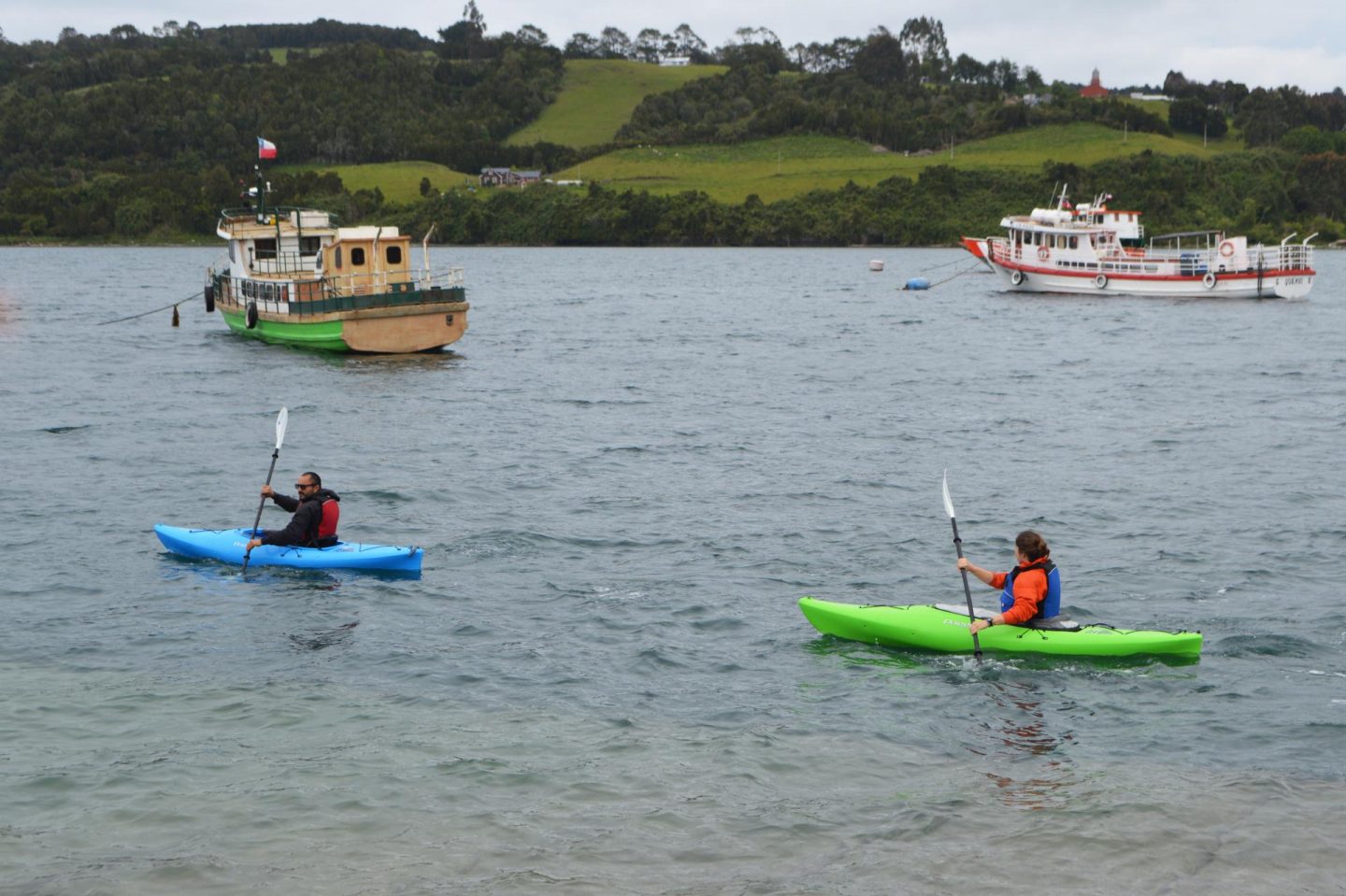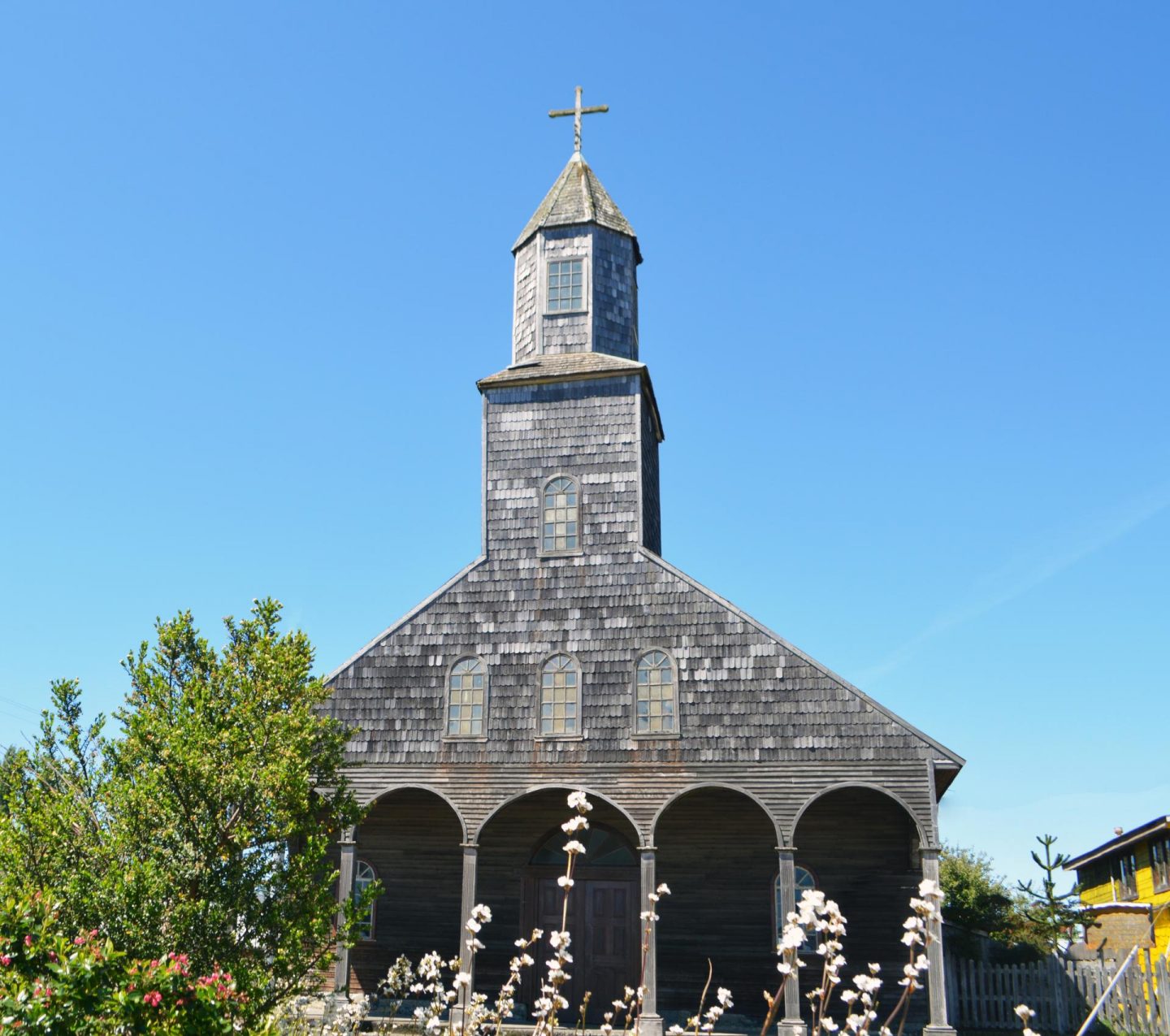
If ever there were islands that seem lifted straight from a story book, it’s the curious archipelago of Chiloé. Perhaps it’s the journey to reach it from Chile’s mainland that made me feel like that – I had come from the wild and dusty Atacama Desert and was thirsty for green lands and blue oceans. The journey across to the islands by ferry from Pargua was like an escape to a new world, especially when striped black and white Magellen penguins began diving in and out of the ferry’s swell.
The land you disembark onto – Chiloé island, the largest of the islands – is just as unexpected. Bright boats bob in the harbours of the fishing villages, where rainbow-hued houses made of the island’s traditional wooden shingles look out to sea. Inland, Chiloé is a patchwork of rich green meadows, grazing cows and wild flowers, thanks to the islands’ mercurial weather and frequent rain. They call Chiloé the ‘land of four in one’, because you’re likely to experience all four seasons in one day.
I stayed at Tierra Chiloé and explored these magical lands by foot, boat and kayak – read on for my Chiloé island guide to my favourite adventures.

My guide to Chiloé islands
All the colours of Chilote markets
Chiloé’s market towns are a feast for the senses, where you’ll find long skeins of dyed wool hang from the ceilings, beautiful wooden trinkets and huge elephant garlic cloves as big as your fist. For keepsakes, try Dalcahue’s artisan market, and for hand-knitted jumpers, hats and delightful woollen toys, explore Castro’s market stalls. Foodie? Achao has an indoor fish market where just-caught seafood is cooked before your eyes – I loved the pastries stuffed with fresh seafood, rather like a Chilote version of a Cornish pasty.

Wander in Chelín’s graveyard
The tiny island of Chelín, which is sleepy even by Chilote standards, is home to the most charming graveyard I’ve ever seen (and I really love old graveyards). A local dog acted as a tour guide when we arrived on the island, leading us past the grassy main square, where one of Chiloé’s beautiful UNESCO-listed timber churches presides over a cluster of pastel-coloured cottages. Beyond it is the island’s fascinating churchyard. It’s like a miniature ghost town, where locals are buried in rather kitch mini versions of their wooden houses, complete with wooden shingles and pretty paint jobs. There’s even a beautifully painted little boat to mark one fisherman’s grave.

Stay at Tierra Chiloé
Some places stay with you forever – one of mine is Tierra Chiloé. This wood-clad stilted lodge stands looking out over Rilan Bay on Big Island, and despite its architecturally stunning looks, it blends perfectly into its rather magical surroundings. Staying here makes you feel very connected to the sea – bedrooms are cosy and earth-toned, facing out to the misty ocean and with the feel of staying in your own little cabin. It’s tempting to stay inside this lovely lodge, but the whole point of all the Tierra Hotels (there are three across Chile) is the adventures and experiences that guests can join each day with Tierra’s expert guides. Go kayaking among the islands, hike remote trails, taking on food safaris, or sail the sea – the hotel has its own wooden boat, the Williche, moored in the bay below, with bright kayaks tied to its roof.

Kayak around the islands
Grab a paddle – the harbours and inlets of Chiloé’s islands are best explored by kayak. You can spend days or even weeks kayak-hopping between the islands with a local guide when the sea is calm, or just spend an hour or two out on the water to gain a different perspective on these seaside communities. I paddled around the Pindo Estuary, off Quehui island, and got to meet some very special locals – two striped Magellanic penguins popped up right in front of our kayaks. Chiloé is rich in folklore, much of it connected to the sea – locals say that ghost galleons, shipwrecked sailors and man-killing mermaids haunt these waters. It’s hard not to keep half an eye out for phantoms as you paddle.

Collect Chilote churches
You don’t need to believe in the heavens above to be charmed by Chiloé’s 18th century churches, which are so special they have their own UNESCO protection. They follow the design of colonial Spanish churches, but with a twist – they are built entirely of timber, with the islands’ traditional wooden slats on the outside and beautifully painted wood on the inside. 16 churches, now bleached to pastel hues by time, still stand on the archipelago, and collecting photos of one in every colour of the rainbow is a rewarding way to hop around the islands by bike and boat.

Hike the coast of Big Island
Of all the walks on La Isla Grande de Chiloé (or the Big Island of Chiloé, Chiloé island’s official moniker), my favourite was from Duhatao to Chepu. My guide from Tierra Chiloé, Javier, and I drove along the Pan-American Highway to reach the island’s wild eastern side, where green meadows give way to rugged cliffs. We picked up part of the Sendero de Chile (or Chilean Trail), a planned route that will connect the entire 2,653 mile-long country in one huge path. We followed a tiny sliver of it along the coast, passing through dark tunnels of trees before emerging to panoramic views of blue sky and big ocean. The trail keeps the sea in sight all the way to Chepu Beach, where you feel like you’ve reached a land before time – enormous gunnera leaves frame the path down to the sand, and a huge rock arch guards the way to the ocean. Then you can walk along the beach for miles to reach Chepu River, and the way back to civilisation. The only beings we met on the whole day’s hike was a herd of cows and a startled deer. Magical.

Visit Chiloé with Last Frontiers
I travelled to Chile with Latin America specialists Last Frontiers, who offers a 13 day trip to Chile, including time to explore Santiago and stays at the Tierra hotels on the Island of Chiloé (three nights) and in the Atacama Desert (four nights) for £5,420 per person, including all meals, drinks, transfers, hikes and other excursions as well as international and internal flights.
